Vetiver root's remarkable fixative properties make it your secret weapon for creating long-lasting fragrances. You'll find this ancient ingredient bonds chemically with other scent molecules, anchoring volatile notes for up to 12 hours on your skin. When you're blending, start with 20% vetiver in your total mixture, focusing on its deep, woody-earthy base notes that complement citrus and floral elements. Discover why perfumers have treasured this aromatic powerhouse since the 12th century.
The Ancient Origins of Vetiver in Perfumery
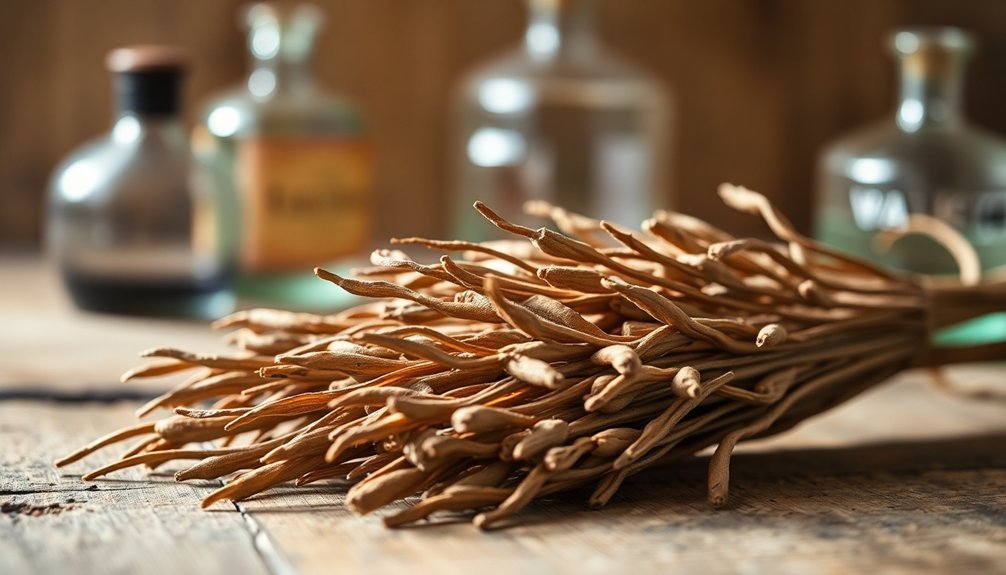
While many modern perfume ingredients have relatively recent origins, vetiver's aromatic legacy stretches back thousands of years to South India, where it first earned its name from the Tamil word "vettiveru."
This perennial plant's journey through history began with ancient indigenous populations who burned its roots in traditional ceremonies and folk magic. Its roots produce a deep grounding scent when processed through distillation.
You'll find vetiver's presence in gardens dating back to the Babylonian Empire (1792-1750 BCE), where it grew alongside other aromatic plants.
When Arabs invented steam distillation in the ninth century, they revealed vetiver's full aromatic potential.
By the 12th century, you could find vetiver essential oil in aromatherapy and perfumery worldwide.
Though it remained largely unknown in Western countries until recently, its soothing and uplifting properties made it a treasured ingredient throughout the Middle Ages.
Understanding Vetiver's Complex Scent Profile
When you first encounter vetiver's aroma, you'll discover a remarkably complex scent that weaves together earthy, woody, and smoky elements.
You'll notice subtle hints of hazelnut and peanut, complemented by fresh, lemony top notes that create a multi-layered experience.
The complexity comes from vetiver's unique chemical composition, including sesquiterpenes and compounds like vetiverol and vetiverone.
Regional variations add to this diversity:
- Haitian vetiver offers cleaner, floral notes
- Indonesian vetiver delivers warmer, smokier tones
- Young rootlets provide green, asparagus-like nuances
You'll find vetiver's versatility especially apparent in perfumery, where it blends beautifully with citrus, floral, and spicy notes. The dense root system helps prevent soil erosion in tropical regions while producing the aromatic compounds used in perfumery.
Its fixative properties help anchor other scents, making it an essential base note in many lasting fragrances.
How Vetiver Acts as a Natural Fixative
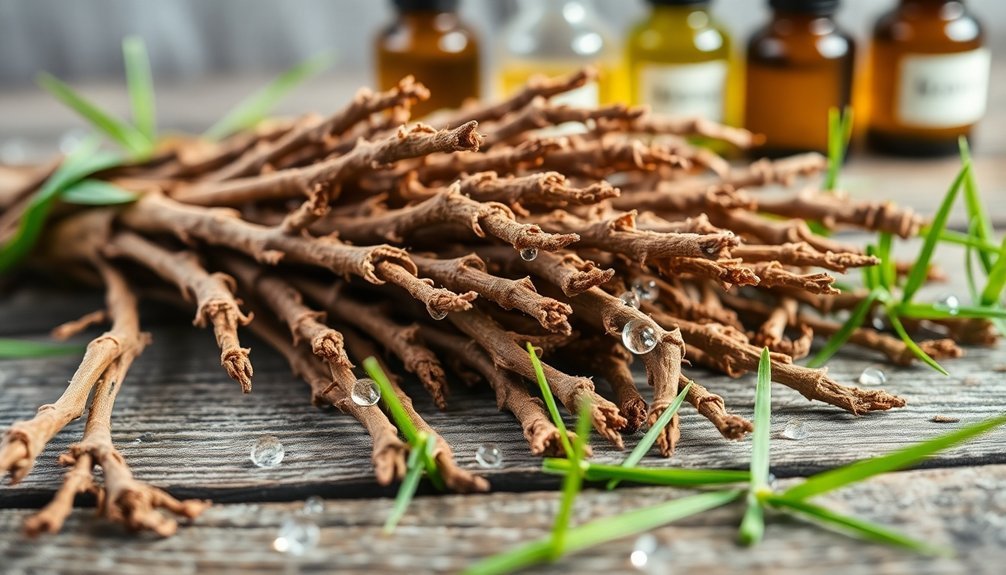
You'll find vetiver's remarkable fixative power comes from its ability to form chemical bonds with other fragrance components, effectively anchoring volatile notes to create lasting scents.
The oil's complex structure, containing over 100 sesquiterpene compounds including khusimol and vetivones, works to slow down the evaporation of lighter fragrance molecules.
When you add vetiver to your perfume formulation, its dense, syrupy nature helps maintain the integrity of your chosen scent for up to 12 hours on the skin. The oil also improves with age, making it an increasingly effective base note in long-lasting fragrances.
Chemical Bonds With Notes
The complex chemical composition of vetiver oil makes it an exceptional natural fixative in perfumery. Its rich blend of sesquiterpenes, particularly the high concentration of sesquiterpene alcohols (45%), creates strong molecular bonds with other fragrance components.
You'll find that these bonds effectively slow down the evaporation of volatile notes in your perfume.
- Khusimol, making up 21.5% of the oil, anchors lighter top notes while adding depth
- The combination of α-vetivone and β-vetivone enhances stability and longevity
- Sesquiterpene hydrocarbons create harmonious bridges between different scent families
When you're working with vetiver, you'll notice how it expertly binds with various fragrance families.
It's particularly effective with florals, spices, and woody notes, creating stable, long-lasting compositions that maintain their integrity throughout the fragrance's lifecycle.
Root's Long-Lasting Impact
Building upon vetiver's molecular bonding properties, its remarkable fixative qualities set it apart in natural perfumery.
When you're crafting fragrances, you'll find that vetiver acts as a natural anchor, stabilizing volatile components and extending their life on your skin. Like a fine wine, vetiver oil improves with age, developing deeper complexity as it undergoes chemical transformation.
You'll notice vetiver's impact in many high-end perfumes, where it serves as an essential bottom note. It's particularly effective in fougère, chypre, and woody-aldehydic bases, where its staying power can extend the overall fragrance duration.
The oil's unique properties stem from its meticulous distillation process, which can exceed 24 hours, extracting precious high-boiling constituents that contribute to its exceptional longevity and depth in perfume compositions.
Extracting and Processing Vetiver Root
Successful extraction of vetiver root oil begins with proper harvesting techniques and specialized processing methods.
You'll need to carefully dig around mature roots, trim the leaves, and prepare them through washing and soaking to optimize oil extraction.
The most effective extraction methods include:
- Hydrodistillation – boiling roots in water for 60-70 hours
- Solvent extraction using hexane, yielding up to 2% oil
- Supercritical CO2 extraction, producing the highest yields of 2.9-3.74%
You'll find that supercritical CO2 extraction preserves more of the root's complex aroma profile than other methods.
During the distillation process, you can collect both high-density and low-density oils through repeated extraction cycles.
The quality of your final product depends heavily on both growth conditions and your chosen extraction technique.
Optimal Ratios for Vetiver in DIY Blends
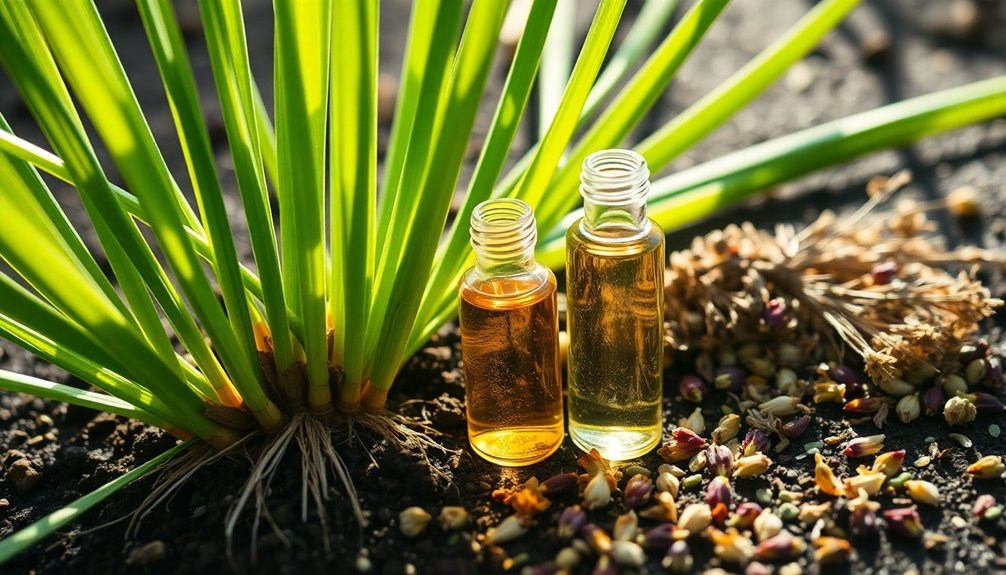
You'll want to start with a conservative amount of vetiver in your DIY blends, using just 20% of your total blend to honor its role as a base note.
When mixing natural vetiver with other essential oils, you can follow the classic 30-50-20 ratio (top, middle, base notes), though you're free to adjust these proportions based on your desired fragrance impact.
For the most balanced results, combine 1-3 drops of vetiver with complementary oils like cedarwood or jasmine, always testing small amounts first to achieve your perfect blend.
Balancing Base Note Strength
When crafting DIY fragrances with vetiver, understanding the best ratios proves essential for achieving a balanced blend. Since vetiver has a strong aroma profile, you'll need to carefully adjust its proportions to avoid overpowering other scents in your mixture.
- Start with small amounts, using 3 drops of vetiver for every 15-20 drops of other essential oils.
- Test your blends on perfume strips, allowing you to evaluate the balance before committing to larger quantities.
- Adjust ratios based on the strength of companion oils – use less vetiver when combining with powerful scents like chamomile.
Remember that you can maintain proportions while scaling your formula up or down.
For example, if you're creating a relaxing blend, combine vetiver with cedarwood and Peru Balsam at a 1:2:2 ratio for best results.
The key is finding harmony between vetiver's deep, earthy notes and your chosen companion oils.
Natural Vs Synthetic Proportions
Understanding natural vetiver's irreplaceable qualities shapes how we approach DIY fragrance ratios.
Since there's no synthetic substitute that can match vetiver's complex composition of over 100 sesquiterpene compounds, you'll need to work carefully with the pure essential oil.
For your DIY blends, keep vetiver at 5-10% of the total mixture to maintain a proper base note presence.
You can create a balanced relaxing blend by combining 3 drops of vetiver with 10 drops of petitgrain, 6 drops of cedarwood Virginian, and 6 drops of Peru Balsam.
When using carrier oils like jojoba or fractionated coconut oil, add vetiver drop by drop until you achieve the desired harmony.
Remember that different regional varieties of vetiver offer distinct scent profiles, with Indian oil particularly prized for its balsamic woody notes.
Essential Oil Mixing Guidelines
Building on the natural properties of vetiver oil, successful DIY blending requires specific mixing ratios and combinations.
You'll want to maintain a 2% dilution rate when mixing with carrier oils, which translates to roughly 100 drops of essential oil blend per 8 ounces of carrier oil.
For ideal results, combine vetiver with complementary oils following these guidelines:
- Mix 3 drops vetiver with 10 drops of citrus oils like bergamot or lemon for an uplifting blend
- Blend 1-2 drops vetiver with 3-4 drops each of lavender and cedarwood for a grounding effect
- Combine 2 drops vetiver with 4 drops each of floral oils like jasmine or rose for a balanced fragrance
Remember that vetiver's deep base note requires careful proportioning with middle and top notes to achieve harmonious blends.
Blending Vetiver With Other Essential Oils
Since vetiver's deep, earthy aroma serves as an excellent base note, it creates remarkable synergies with a wide range of essential oils.
You'll find it blends beautifully with lavender, bergamot, and chamomile for a soothing atmosphere, while combining it with cedarwood and sandalwood creates a grounding effect.
For citrus-based blends, try mixing vetiver with lemon, orange, or tangerine to achieve an invigorating yet balanced fragrance.
If you're seeking therapeutic benefits, pair it with black pepper and ginger for energy, or blend with lavender and lemon to reduce anxiety.
The oil also works wonderfully with floral notes like jasmine and rose, adding depth and longevity to your blends.
For meditation purposes, combine vetiver with bergamot and geranium to enhance its grounding properties.
Storage and Shelf Life of Vetiver Oil
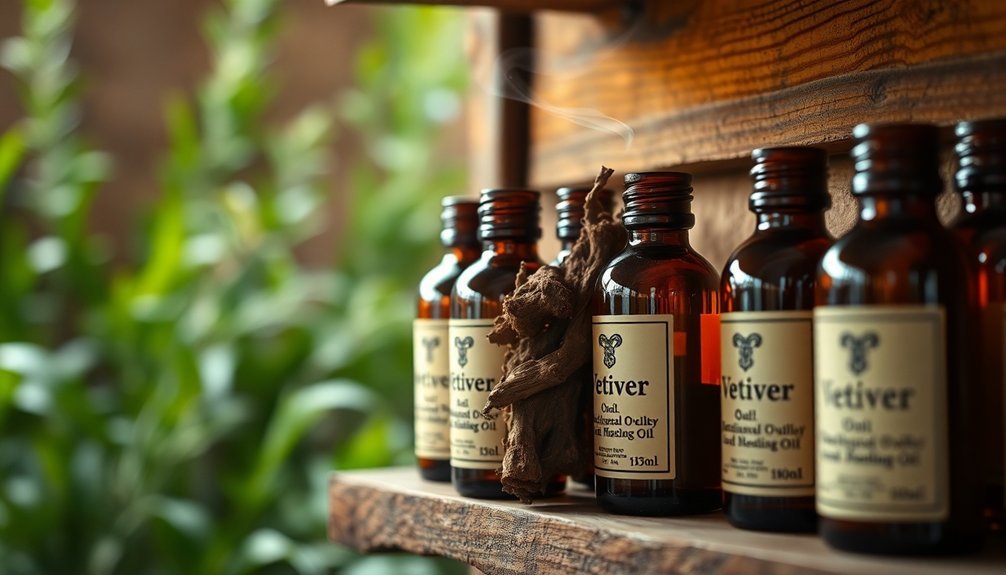
While mastering vetiver oil blends enhances your fragrance creation, proper storage guarantees your oils maintain their potency and therapeutic value.
You'll want to store your vetiver oil in a cool, dark place using an airtight container to prevent contamination and maintain its quality.
Unlike other essential oils, vetiver's unique characteristics include:
- A remarkably long shelf life that spans several years
- An aging process that improves the oil's aroma, similar to fine wine
- A deepening and sweetening of scent after 6 months of proper storage
Remember to keep your vetiver oil away from direct sunlight and heat sources, and store it in a dry area inaccessible to children.
Regularly check for signs of oxidation or spoilage to verify your oil remains in prime condition for aromatherapy use.
Testing Vetiver Oil Quality at Home
You can start testing your vetiver oil's quality at home by examining its appearance on a white surface, looking for a pale yellow to greenish-brown color and checking that it doesn't darken quickly.
A simple dilution test will help confirm authenticity – just place a drop on paper and observe if it absorbs within 30 minutes, as pure vetiver oil should.
When inspecting the oil visually, you'll also want to check for its characteristic thick consistency and verify there aren't any visible impurities or sediments floating in it.
Visual Inspection Methods
Four reliable visual inspection methods can help you determine the quality of vetiver essential oil at home.
Start by examining the oil's color, which should range from light amber to dark brown, with premium quality being clearer. Check for any black spots or quick darkening on white surfaces, as these indicate poor quality.
- Place a drop on white paper and observe if it darkens within seconds – quality oil maintains its original color.
- Check the oil's consistency – authentic vetiver should be viscous, indicating high quality.
- Perform the absorption test by placing oil on paper – pure oil should absorb within 30 minutes.
These visual tests work together to help you assess purity.
Remember to look for a pleasant woody, earthy aroma with fresh herbal undertones, as scent complements visual inspection in determining quality.
Quick Dilution Test
A simple dilution test can quickly reveal the authenticity of vetiver essential oil. When you mix the oil with a carrier oil, it should blend smoothly and maintain its characteristic earthy, sweet-woody aroma.
You'll want to observe how the oil behaves during and after dilution. To perform this test, warm the oil slightly in a water bath and mix it with your chosen carrier oil. High-quality vetiver will maintain its thick consistency before warming and return to this state once cooled.
If it stays thin or doesn't regain its original viscosity, you might've an adulterated product. Remember to conduct a patch test on your skin with the diluted mixture – genuine vetiver shouldn't cause irritation when properly diluted.
Watch for the expected benefits like stress relief or skin improvement to confirm quality.
Common Mistakes When Using Vetiver
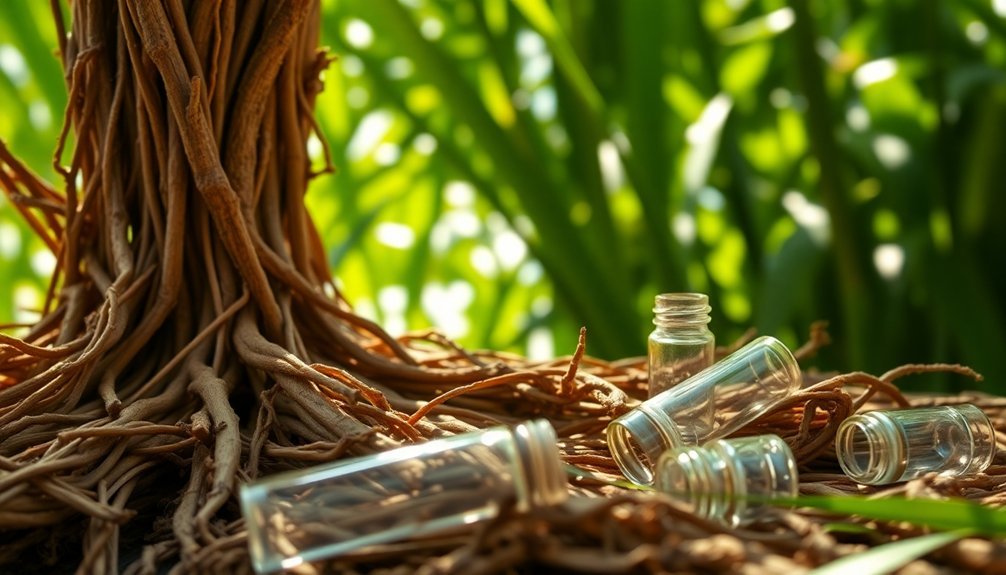
While vetiver root offers numerous benefits for fragrance and wellness applications, many people make common mistakes that can diminish its effectiveness.
If you're using vetiver for infusions or tea, proper root preparation is essential. Don't skip washing the roots thoroughly, and remember to chop them before boiling to maximize the release of beneficial compounds.
- When making vetiver tea, steep the roots for 2-4 hours and avoid boiling them too long, as this can destroy delicate compounds.
- Store your vetiver roots in a cool, dry place to maintain their aromatic properties, and replace them regularly in infused water.
- For aromatherapy and pest control, use the right amount of roots and place them strategically – too few won't be effective, while too many can overwhelm.
Pay attention to proper straining techniques and consider adding complementary ingredients like lemon or ginger to enhance the benefits.
Seasonal Applications of Vetiver
Understanding vetiver's proper usage leads naturally to exploring its unique seasonal applications. You'll find vetiver particularly versatile during summer and autumn months. In summer, it's invaluable for cooling and hydration through vetiver curtains, hats, and infused drinking water. The root's cooling properties make it perfect for revitalizing beverages like khus syrup and flavored lassi.
| Season | Primary Uses | Key Benefits |
|---|---|---|
| Summer | Cooling curtains | Temperature control |
| Summer | Infused drinks | Heat relief |
| Summer | Light fragrances | Fresh, citrus notes |
| Autumn | Deep perfumes | Earthy comfort |
| Autumn | Spicy blends | Seasonal harmony |
When autumn arrives, you'll want to switch to deeper, more intense vetiver fragrances that complement the season's natural earthiness. The root's woody characteristics blend perfectly with autumn's rich sensory palette, making it an essential fragrance anchor as temperatures cool.
Sourcing High-Quality Vetiver Root
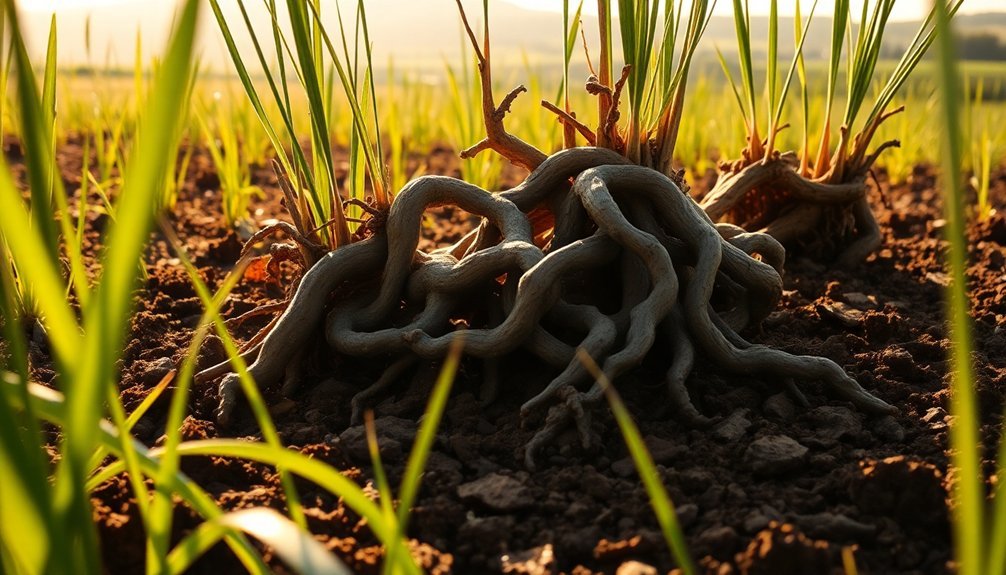
To source premium vetiver root, you'll need to evaluate several essential factors that influence its quality and potency. Look for thick, smooth roots with minimal branching, as these characteristics indicate higher essential oil content in the phloem.
The harvesting timing is vital – roots should be extracted when the plant is 2-3 years old, ideally between August and December.
For the best quality vetiver, make sure your sources follow these critical practices:
- Proper cultivation in tropical environments with adequate sunlight and water supply
- Careful extraction methods that preserve the root's integrity, as they can grow up to 13 feet deep
- Appropriate post-harvest handling, including proper drying and preparation for distillation
When selecting suppliers, verify their distillation process meets industry standards, as this greatly impacts the final oil quality.
Safety Guidelines for Working With Vetiver
Since working with vetiver involves potential risks, you'll need to follow strict safety protocols to protect yourself and the environment.
Wear protective equipment including chemical-resistant gloves, safety goggles, and an approved respirator with organic vapor cartridges when handling the material. Keep your workspace well-ventilated and away from heat sources or open flames.
Store vetiver in sealed containers in a cool, dry area. If you spill any product, clean it up immediately to prevent environmental contamination. Don't let it enter drains or water sources.
If skin contact occurs, wash thoroughly with soap and water. For eye exposure, rinse carefully and remove contact lenses if present. Seek medical attention if irritation persists.
Pregnant women should avoid working with vetiver due to potential risks of miscarriage.
Creating Your Signature Vetiver Base
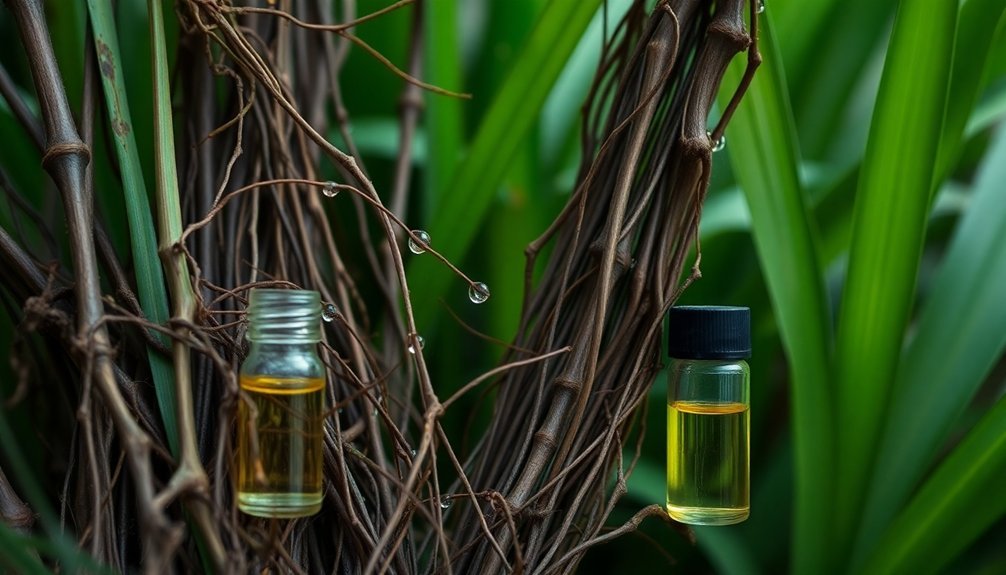
With proper safety measures in place, you're ready to explore the art of creating your own vetiver-based fragrance.
Start by understanding vetiver's deep, earthy profile and its exceptional ability to anchor other scents. You'll find this versatile base note works beautifully with a wide range of complementary oils.
To craft your signature blend, consider these essential combinations:
- Mix vetiver with bergamot or lemon for a bright, grounding fragrance
- Pair it with rose or geranium to create an elegant, balanced composition
- Combine it with sandalwood or cedarwood for a rich, lasting woody scent
Experiment with different ratios until you achieve your desired effect.
Frequently Asked Questions
Why Do Some People Experience Headaches When Wearing Vetiver-Based Fragrances?
You may get headaches from vetiver fragrances because they contain potent oils and synthetic compounds that can overstimulate your olfactory nerves, trigger allergic reactions, or activate your brain's pain pathways.
Can Vetiver Essential Oil Stain Clothing or Fabrics?
Yes, vetiver essential oil will stain your clothing and fabrics. Its dark amber color and thick consistency make it highly staining, especially on porous materials. You'll need quick treatment to prevent permanent marks.
Does Altitude Affect Where Vetiver Can Be Successfully Grown?
You can grow vetiver at most altitudes as long as temperatures don't drop below -9.5°C. It thrives from sea level to 3,000 meters, with successful plantings in Honduras at 2,800m and Ethiopia at 2,000m.
Is Synthetic Vetiver as Effective as Natural Vetiver for Aromatherapy?
You can't compare synthetic vetiver's aromatherapy effects since it doesn't exist commercially. Natural vetiver's complex therapeutic properties, including stress relief and anxiety reduction, remain unmatched as no synthetic alternative is available.
Why Does Vetiver Oil's Scent Vary Significantly Between Different Geographical Regions?
You'll notice vetiver oil's scent varies because soil composition, climate, and growing conditions differ between regions. These factors directly impact the root's chemical makeup and resulting aroma during extraction.
In Summary
You're now ready to explore vetiver's remarkable versatility in your own fragrance creations. Start with small amounts in your blends, noting how it anchors and enhances other scents. Don't hesitate to experiment with different varieties and concentrations. Whether you're crafting a signature perfume or enhancing your aromatherapy practice, vetiver's deep, earthy presence will transform your scent work into lasting aromatic masterpieces.





Leave a Reply